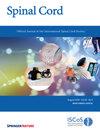脊髓损伤中二硫塌陷相关基因和亚群的鉴定。
IF 2.2
4区 医学
Q3 CLINICAL NEUROLOGY
引用次数: 0
摘要
研究设计:生物信息学分析和实验验证研究。目的:探讨脊髓损伤相关基因在脊髓损伤(SCI)中的作用和表达模式,寻找潜在的关键基因,探索可能的治疗靶点。背景:中国上海。方法:数据采集及预处理:根据文献筛选27个二硫塌陷相关基因,并从GEO数据库(GSE151371)下载ASCI患者rna测序数据;差异表达基因(deg)鉴定:使用R包“limma”进行ASCI样本与正常对照差异基因表达分析;免疫细胞浸润评估:采用ssGSEA算法和CIBERSORT确定免疫细胞丰度;关键基因的鉴定与功能验证:将二硫裂病相关基因与deg交叉,利用机器学习技术(Random Forest, Lasso, Support Vector machine)鉴定枢纽基因。实时荧光定量PCR验证枢纽基因表达;诊断模型构建:建立基于枢纽基因和临床特征的反向传播神经网络临床预测模型,并采用ROC曲线对其性能进行评价。6. 亚类分析:对ASCI样本和枢纽基因进行一致聚类分析,利用GSVA分析亚群间功能差异。结果:在ASCI中鉴定出7764个deg,在炎症和自噬相关通路中富集GO和KEGG;发现ASCI组免疫细胞浸润与对照组存在差异,免疫细胞与DRGs存在相关性;通过机器学习确定了7个枢纽基因(MYL6、NUBPL、CYFIP1、IQGAP1、FLNB、SLC7A11、CD2AP);通过qRT-PCR验证hub基因的表达;构建了预测准确率较高的临床诊断模型(总体数据集准确率为83.3%);根据中枢基因鉴定出两种ASCI亚型,具有不同的免疫浸润和途径活性。结论:双上睑下垂与脊髓损伤密切相关。中心基因和亚型的鉴定为生物标志物和治疗靶点的研究提供了新的思路。该诊断模型具有临床应用潜力,但由于样本量小等局限性,尚需进一步研究。项目资助:中国人民解放军青年科技人才项目(2020QN06125)、海军医科大学第一附属医院长虹人才项目(魏贤昭)、海军医科大学第一附属医院基础医学研究项目(2023PY17)为本研究的部分资助项目。我想重申,在提交这篇稿件时,没有事先发表任何数据或表格,也没有利益冲突。图形摘要分为两部分。上半部分依次显示脊髓损伤后人体内二翘下垂的发生及免疫微环境的变化。下半部分为通过检测二硫塌陷相关基因的变化,结合患者临床资料构建脊髓损伤诊断模型。本文章由计算机程序翻译,如有差异,请以英文原文为准。

Identification of disulfidptosis-related genes and subgroups in spinal cord injury
Bioinformatics analysis and experimental validation study. To investigate the role and expression patterns of disulfidptosis-related genes in spinal cord injury (SCI), identify potential pivotal genes, and explore possible therapeutic targets. Shanghai, China. Data acquisition and pre-processing: Screened 27 disulfidptosis-related genes based on literature and downloaded RNA-sequencing data of ASCI patients from GEO database (GSE151371); Identification of differentially expressed genes (DEGs): Used R package “limma” for differential gene expression analysis between ASCI samples and normal controls; Evaluating immune cell infiltration: Employed ssGSEA algorithm and CIBERSORT to determine immune cell abundance; Identification and functional verification of key genes: Intersected disulfidptosis-related genes with DEGs, and used machine learning techniques (Random Forest, Lasso, Support Vector Machine) to identify hub genes. Validated hub genes expression by real-time PCR; Construction of a diagnostic model: Developed a backpropagation neural network clinical prediction model based on hub genes and clinical features, and evaluated its performance using ROC curve. 6. Subcluster analysis: Performed consensus cluster analysis of ASCI samples and hub genes, and used GSVA to elucidate functional differences between subgroups. Identified 7764 DEGs in ASCI, with GO and KEGG enrichment in inflammation and autophagy-related pathways; Found differences in immune cell infiltration between ASCI and control groups, and correlation between immune cells and DRGs; Determined seven hub genes (MYL6, NUBPL, CYFIP1, IQGAP1, FLNB, SLC7A11, CD2AP) through machine learning; Validated the expression of hub genes by qRT-PCR; Constructed a clinical diagnostic model with good predictive accuracy (overall dataset accuracy of 83.3%); Identified two subtypes of ASCI based on hub genes, with different immune infiltration and pathway activity. Disulfidptosis is closely related to spinal cord injury. The identified hub genes and subtypes provide new insights for biomarker and therapeutic target research. The diagnostic model has potential for clinical application, but further studies are needed due to limitations such as small sample size. This study was supported in part by the project of Youth Scientific and Technological Talents of PLA (2020QN06125), Changhong Talent Project in First affiliated hospital of Navy Medical University (Wei Xianzhao) and Basic Medical Research Project in First affiliated hospital of Navy Medical University (2023PY17). I want to reiterate that there is no prior publication of figures or tables and no conflict of interest in the submission of this manuscript.
求助全文
通过发布文献求助,成功后即可免费获取论文全文。
去求助
来源期刊

Spinal cord
医学-临床神经学
CiteScore
4.50
自引率
9.10%
发文量
142
审稿时长
2 months
期刊介绍:
Spinal Cord is a specialised, international journal that has been publishing spinal cord related manuscripts since 1963. It appears monthly, online and in print, and accepts contributions on spinal cord anatomy, physiology, management of injury and disease, and the quality of life and life circumstances of people with a spinal cord injury. Spinal Cord is multi-disciplinary and publishes contributions across the entire spectrum of research ranging from basic science to applied clinical research. It focuses on high quality original research, systematic reviews and narrative reviews.
Spinal Cord''s sister journal Spinal Cord Series and Cases: Clinical Management in Spinal Cord Disorders publishes high quality case reports, small case series, pilot and retrospective studies perspectives, Pulse survey articles, Point-couterpoint articles, correspondences and book reviews. It specialises in material that addresses all aspects of life for persons with spinal cord injuries or disorders. For more information, please see the aims and scope of Spinal Cord Series and Cases.
 求助内容:
求助内容: 应助结果提醒方式:
应助结果提醒方式:


